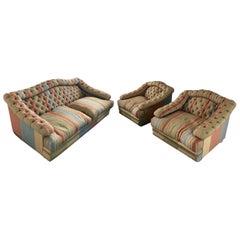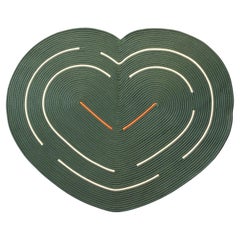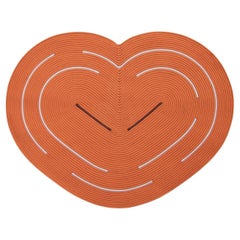Valentino Piu
20th Century Italian Valentino Piu Set of Canape and Two Armchairs
Located in Sofia, BG
VALENTINO PIU, Made in Italy.
Sofa and pair of large armchairs in colourful striped fabric, very
Category
Late 20th Century Italian Canapes
Materials
Cotton
$4,415
H 35.04 in W 82.68 in D 42.52 in
Tappeto Valentino in Colore Verde Filato Tecnico by Deanna Comellini 85x105 cm
By Deanna Comellini
Located in Bologna, IT
del brand, Valentino è più di un semplice tappeto, è un piccolo accessorio di design che, grazie alla
Category
2010s Indian Modern Western European Rugs
Materials
Other
$538 / item
W 33.47 in L 41.34 in
Tappeto Design Italiano Valentino per Bagno e Outdoor Deanna Comellini 85x105 cm
By Deanna Comellini
Located in Bologna, IT
del brand, Valentino è più di un semplice tappeto, è un piccolo accessorio di design che, grazie alla
Category
2010s Indian Modern Western European Rugs
Materials
Other
$538 / item
W 33.47 in L 41.34 in
People Also Browsed
'Plissé White Edition' Pleated Textile Table Lamp by Folkform for Örsjö
By Örsjö Industri AB
Located in Glendale, CA
'Plissé White Edition' pleated textile table lamp by Folkform for Örsjö.
This unique table lamp was awarded “Lighting of the Year 2022” by Residence Magazine Sweden, who called it “...
Category
21st Century and Contemporary Swedish Mid-Century Modern Table Lamps
Materials
Textile
$1,320 Sale Price / item
20% Off
H 16.1 in Dm 11.5 in
Italian Riviera Franco Albini Rattan Square Sunburst Mirror, Loop Design, 1950s
By Franco Albini
Located in Barcelona, ES
Midcentury Franco Albini Rattan Mirror
___________________________________________________________
A highly decorative squared Mid-Century Modern mirror with undulated rattan frame a...
Category
Mid-20th Century Italian Mid-Century Modern Wall Mirrors
Materials
Cane, Rattan, Mirror
$2,692
H 18.12 in W 18.12 in D 1.38 in
Round Botanical Tile Top Coffee Table By Roger Capron, France, 1965
By Roger Capron
Located in Los Angeles, CA
This round French coffee table, stamped Capron and dated circa 1965, highlights the artistry of Roger Capron’s celebrated mid-century ceramic work. The beautifully composed tile top ...
Category
Vintage 1960s French Mid-Century Modern Coffee and Cocktail Tables
Materials
Ceramic, Wood
Custom Made Modern English Arm Sofa in Performance Linen Velvet - 86"
By Bloom Home Inc
Located in Old Town Orange, CA
This beautiful english arm sofa has a modern twist, with its single bench cushion, and beautiful curved apron sides. It’s upholstered in a Linen Velvet Performance fabric.
Shown in...
Category
21st Century and Contemporary American Sofas
Materials
Linen, Velvet
$4,900 / item
H 34 in W 86 in D 42 in
Rare Original Eva Chair by Giovanni Travasa, Italy, 1960s
Located in Lewes, East Sussex
A rare, original 1960s Eva Chair designed by Giovanni Travasa in 1965, and produced by Bonacina, Italy. This example from a now closed independent boutique in Torino in rare white ...
Category
Mid-20th Century Italian Mid-Century Modern Lounge Chairs
Materials
Fabric, Bamboo
$9,199 / set
H 28.35 in W 35.44 in D 25.6 in
Rare Mid Century Walnut & Oak Dining Table by Lou Hodges, c1970s
By Lou Hodges
Located in Chino Hills, CA
Elevate your dining room with this exquisite vintage dining table, a testament to the unparalleled craftsmanship and innovative design ethos of the 1970s. Believed to be a custom pie...
Category
Vintage 1970s American Mid-Century Modern Dining Room Tables
Materials
Oak, Walnut
$9,000 Sale Price
40% Off
H 31 in W 41 in D 104 in
Milani, Transparent Green Polycarbonate Dining Chair
Located in Beverly Hills, CA
Scroll down and click "view all from Seller" to see more than 400 other unique products. (2.2)
Milani, Transparent Bottle Green Polycarbonate dining chair
A dedication to the belove...
Category
21st Century and Contemporary Italian Modern Dining Room Chairs
Materials
Plastic
Opinion Ciatti Mammamia Non Stackable Chair
By Opinion Ciatti
Located in Brooklyn, NY
Mammamia chair with die-cast aluminum shell and steel structure. For indoor/outdoor use. Non-stackable. Available in gold structure with white or black painted finish, or mirrored al...
Category
21st Century and Contemporary Italian Modern Chairs
Materials
Metal
Double Bonnet Dome Top Burl Wood 3 Drawer Drop Front Secretary Desk 1900s Clean!
By Baker Furniture Company, Berkey & Gay Furniture, Henredon
Located in Rockaway, NJ
Double Bonnet Dome Top Burl Wood 3 Drawer Drop Front Secretary Desk 1900s Clean!
Category
20th Century American Adam Style Desks and Writing Tables
Materials
Brass
$3,600
H 83 in W 40 in D 17 in
Rainbow Table in Mainneville (Standard Size) by Laura Gonzalez
By laura gonzalez
Located in Paris, FR
The signature Rainbow dining table is made with multi-colored ceramic marquetry handmade by the craftswoman Fabienne L’Hostis. The enameled ceramic tiles are made implementing the Ja...
Category
2010s French Modern Tables
Materials
Enamel
$76,493 / item
H 29.53 in W 118.12 in D 51.19 in
Mixed-Woods "Gallery One" Dining Table by Milo Baughman for Directional
By Directional, Milo Baughman
Located in Brooklyn, NY
Mixed-woods dining table designed by Milo Baughman for Directional's "Gallery One" line (ca. 1961, USA). Composed of alternating banding of walnut, rosewood and butternut (original b...
Category
Vintage 1960s American Mid-Century Modern Dining Room Tables
Materials
Rosewood, Walnut
$6,500
H 30.25 in W 72 in D 39 in
Casa Wall Light No2
By Project 213A
Located in Macieira de Sarnes, PT
Casa Wall Light No 2 in sorbet pink
Designed by Project 213A in 2023
Artisanal ceramic light with textured finish, made in Project 213A's own ceramic workshop.
Each piece is unique ...
Category
21st Century and Contemporary Portuguese Modern Wall Lights and Sconces
Materials
Ceramic
Vintage Adrian Pearsall "Strictly Spanish" Coffee Table by Craft Associates
By Craft Associates, Adrian Pearsall
Located in Brooklyn, NY
Designed by mid-century American modern master Adrian Pearsall for his Craft Associates Furniture brand of Wilkes-Barre, Pennsylvania, this "Strictly Spanish" coffee table is simply ...
Category
Mid-20th Century American Mid-Century Modern Coffee and Cocktail Tables
Materials
Stone
$2,400
H 14 in W 54 in D 22 in
Small 'Tres' Hand-Loomed Rug for Nanimarquina
By Nanimarquina, Nani Marquina & Elisa Padrón
Located in Glendale, CA
Small 'Tres' hand-loomed rug for Nanimarquina.
Fabricated from a natural blend of New Zealand wool, felt, and cotton, 'Tres' is a traditional Indian flat-weave Dhurrie rug. Its un...
Category
21st Century and Contemporary Spanish Modern Western European Rugs
Materials
Wool, Felt, Cotton
19th Century Two French Large Armchairs in Wool Upholstery
Located in Sofia, BG
Two French armchairs forming a pair, but could be used separately as an accent in your home. Frames are carved wooden sheep bones decorated with foliage scrolls with high winged back...
Category
Antique Late 19th Century French Armchairs
Materials
Wool, Wood
$1,974 Sale Price / item
50% Off
H 41.34 in W 27.96 in D 25.99 in
Helmut Newton Sumo Taschen Signed Limited Edition with Philippe Starck Stand
Located in Sofia, BG
Monte Carlo: Taschen, 1999. First edition. 400 duotone reproductions of photographs selected and edited by June Newton. Signed in wax pencil and stamped number 04446 (front endpaper)...
Category
Late 20th Century German Books
Materials
Stainless Steel
$11,578 Sale Price
25% Off
H 27.96 in W 19.97 in D 2.21 in
Get Updated with New Arrivals
Save "Valentino Piu", and we’ll notify you when there are new listings in this category.
Valentino Piu For Sale on 1stDibs
Find many varieties of an authentic valentino piu available at 1stDibs. Each valentino piu for sale was constructed with extraordinary care, often using animal skin, leather and wood. There are 7 variations of the antique or vintage valentino piu you’re looking for, while we also have 2 modern editions of this piece to choose from as well. You’ve searched high and low for the perfect valentino piu — we have versions that date back to the 20th Century alongside those produced as recently as the 21st Century are available. A valentino piu, designed in the modern style, is generally a popular piece of furniture. You’ll likely find more than one valentino piu that is appealing in its simplicity, but Deanna Comellini produced versions that are worth a look.
How Much is a Valentino Piu?
A valentino piu can differ in price owing to various characteristics — the average selling price 1stDibs is $3,000, while the lowest priced sells for $483 and the highest can go for as much as $8,984.






